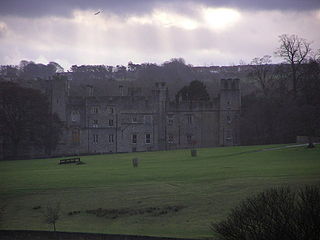David Michael Chaytor is a former British Labour Party politician, who was the Member of Parliament (MP) for Bury North from 1997 to 2010. He was the first member of Parliament to be sentenced following the United Kingdom Parliamentary expenses scandal of 2009.
James Wilson may refer to:
Steven John Chaytor is an Australian politician. He was a Labor Party member of the New South Wales Legislative Assembly from 2005 to 2007, representing the southwest Sydney electorate of Macquarie Fields.
Sir William Chaytor, 1st Baronet was a British politician and businessman.
Sir William Richard Carter Chaytor, 2nd Baronet was a British politician and businessman.
Events from the year 1824 in Ireland.
The Chaytor family is an English gentry family on which has been conferred two baronetcies, one in the Baronetage of England and one in the Baronetage of the United Kingdom and several knighthoods. As of 2008 one baronetcy is extinct.

Major General Sir Edward Walter Clervaux Chaytor, was a farmer, and a military commander of New Zealand troops in the Boer War and the First World War.
Events from the year 1764 in Ireland.
Events from the year 1759 in Ireland.
William Chaytor was a British lawyer and politician who sat in the House of Commons from 1774 to 1790.
Captain Joshua David Gerald Chaytor was an Irish-born cricketer. A right-handed batsman and right-arm fast-medium bowler, he played first-class cricket in the 1924 English cricket season and also represented the Egypt national cricket team.

Witton Castle is a much-altered 15th-century castle, which is the centrepiece of a holiday and caravan country park at Witton le Wear, near Bishop Auckland, County Durham. It is a Grade II* listed building.
Captain Sir Thomas Liddell, 1st Baronet (1578–1652) was an English politician, a member of the Liddell family which monopolized the local government of the North of England during the 16th and 17th centuries. He was one of the leading supporters of the Royalist cause in the English Civil War.
The Third Transjordan attack by Chaytor's Force, part of the British Empire's Egyptian Expeditionary Force (EEF), took place between 21 and 25 September 1918, against the Ottoman Empire's Fourth Army and other Yildirim Army Group units. These operations took place during the Battle of Nablus, part of the Battle of Megiddo which began on 19 September in the final months of the Sinai and Palestine Campaign of World War I. Fought on the right flank and subsidiary to the Battle of Nablus, the Third Transjordan attack began northwards, with the assault on Kh Fasail. The following day a section of Chaytor's Force, attacked and captured the Ottoman Empire's 53rd Division on the main eastwards line of retreat out of the Judean Hills across the Jordan River. Retreating columns of the Yildirim Army Group were attacked during the battle for the Jisr ed Damieh bridge, and several fords to the south were also captured, closing this line of retreat. Leaving detachments to hold the captured bridge and fords, Chaytor's Force began their eastwards advance by attacking and capturing the Fourth Army garrison at Shunet Nimrin on their way to capture Es Salt for a third time. With the Fourth Army's VIII Corps in retreat, Chaytor's Force continued their advance to attack and capture Amman on 25 September during the Second Battle of Amman. Several days later, to the south of Amman, the Fourth Army's II Corps which had garrisoned the southern Hejaz Railway, surrendered to Chaytor's Force at Ziza, effectively ending military operations in the area.
Chaytor's Force named after its commander, Major General Edward Chaytor, was a composite division-sized force which served in the British Egyptian Expeditionary Force during the Sinai and Palestine Campaign of the First World War. The force of 11,000 men, consisted of a division headquarters, three mounted and one infantry brigades, four independent infantry battalions and four artillery batteries and was detached from the Desert Mounted Corps for deception operations.

The Second Battle of Amman was fought on 25 September 1918 during the Third Transjordan attack as part of the Battle of Nablus which together with the main Battle of Sharon form the major set piece offensive known as the Battle of Megiddo of the Sinai and Palestine Campaign in World War I. After cutting the road from Nablus to Es Salt on 22 September Chaytor's Force captured the bridge over the Jordan River at Jisr ed Damieh while units of the Seventh Army and remnants of the Eighth Army were still in retreating towards the bridge from the Judean Hills. Having cut this line of retreat, Chaytor's Force proceeded eastwards to attack and capture Es Salt, before riding on to attack and capture the Ottoman rearguard of the Fourth Army defending Amman. These British Empire victories of the Third Transjordan attack over Yildirim Army Group forces, followed two unsuccessful EEF attacks across the Jordan River in March and April 1918.
Henry John Chaytor (1871–1954), British academic, classicist and hispanist, was Master of St Catharine's College, Cambridge from 1933 to 1946.
Tom Chaytor was an Irish tennis player. Two of his brothers also played tennis, including 1890 Wimbledon quarter finalist David Grainger Chaytor. Tom played at Wimbledon once in 1894, where he beat Horace Chapman, Clement Cazalet and Ernest George Meers, before handing a walkover to Wilfred Baddeley in the semi finals. In 1894, Chaytor reached the final of the Irish Open, where he faced Joshua Pim. Chaytor hit great passing shots and his backhand was winning him a lot of points. Pim won, but only by the score of 9–7 in the fifth set.
This page is based on this
Wikipedia article Text is available under the
CC BY-SA 4.0 license; additional terms may apply.
Images, videos and audio are available under their respective licenses.


